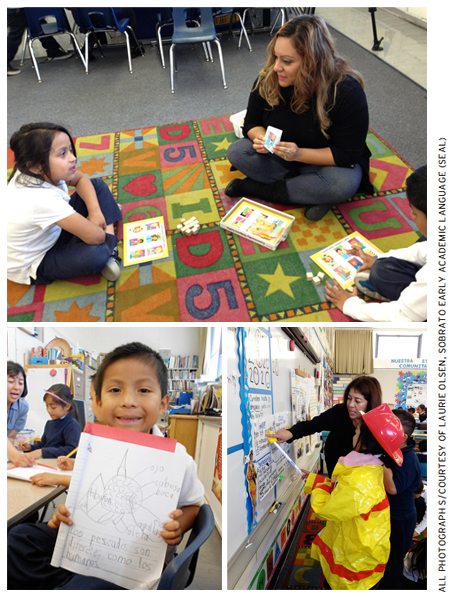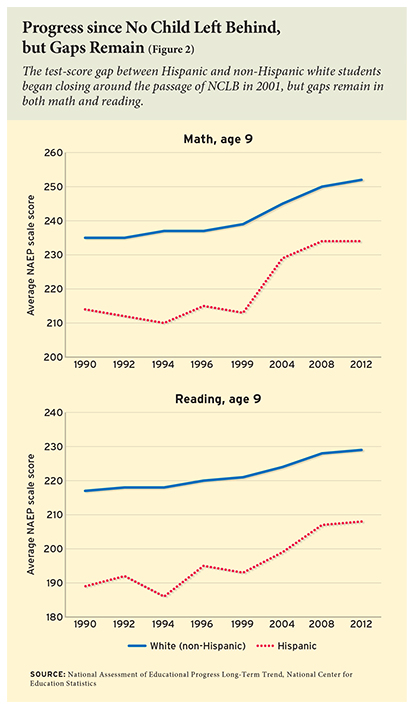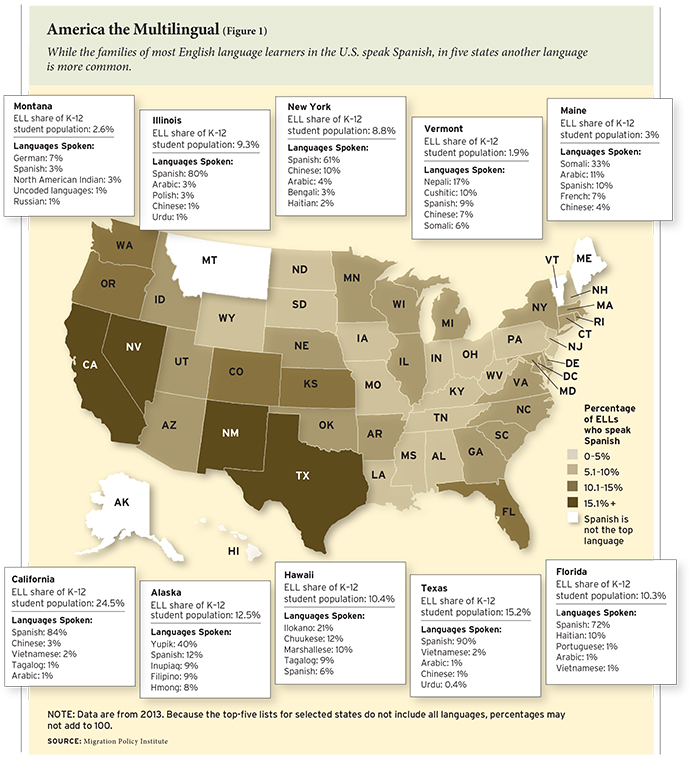
Ocean animals was the theme in pre-kindergarten classes at a California school in early May. Some pre-K teachers introduced “octopus” and “tentacle,” while others taught “pulpo” and “tentaculo.” In all the pre-K classes, children acted out vocabulary words with hand movements, sang songs, and played a guess-the-ocean creature game. Then they moved to tables, where some of them painted paper octopuses, while others gingerly smelled, touched, and then dangled little octopuses from a local fish market.
Down the hall, kindergartners wrote about their favorite desert animals, talked with a partner about where cacti grow, and chanted about biomes:
Arid deserts drying
Luscious forests growing
Polar caps freezing
Green prairies growing …
First graders discussed a story their teacher had read aloud in which a grandfather remembers courting his wife. In Common-Core style, they cited “clues” from the text of the grandfather’s feelings and learned words to describe emotions.
“How do you know he’s happy?” asked Heidi Conti, the teacher.
“He ‘winked’ at the boy,” answered a student.
“Good,” responded Conti. “You made an inference.”
Ninety-five percent of students at Redwood City’s Hoover School, in San Mateo County, come from low-income and working-class Latino families, and nearly all start school as English language learners (ELLs). The elementary and middle school piloted the Sobrato Early Academic Language (SEAL) program in 2009 in hopes of raising reading and math scores and moving more students to the college track.
Programs like SEAL offer a fresh approach to educating English language learners. The focus in schools is shifting “from the language of instruction to the quality of instruction,” says Kenji Hakuta, a Stanford professor who specializes in language learning. As a result, long-standing debates about whether English learners should be taught only in English or also in their native tongue feel increasingly obsolete.
Spanish—and Somali
Close to 5 million U.S. students—about 9 percent of public school enrollment—are ELLs. Three-quarters of them were born in the U.S. and are the children—or grandchildren—of immigrants, according to a Migration Policy Institute analysis of 2013 U.S. Census data. Nearly 80 percent of ELLs come from Spanish-speaking homes, but the rest may speak Chinese, Vietnamese, French/Haitian Creole, Arabic, or any one of hundreds of other languages. In Maine, the most common language spoken by ELLs is Somali (see Figure 1). South Carolina’s second most-common language, after Spanish, is Russian. Illinois schools enroll students from families that speak Arabic, Polish, Chinese, and Urdu.
ELLs usually learn “social” or “playground” English quickly, but many struggle to master the “academic” English vocabulary needed to read complex texts, write clearly, and understand concepts.
Pushed by No Child Left Behind’s (NCLB) accountability measures and the college-for-all movement, educators nationwide have raised expectations for children from immigrant families. Despite moves to ease limits on bilingual education in California and Massachusetts, more ELLs are now learning in English, taught by teachers who use an array of strategies to reach nonfluent students.
Students need strong reading and writing skills in English to have any chance of success in college. Long-term ELLs—those who haven’t reclassified after five years—often drop out of high school or graduate without the skills needed to train for a job or pass a community college class. Reaching English proficiency by middle school is critical for success in high school and beyond. Those who do are likely to take college-prep courses. Those who don’t are not. Most educators would like students to be bilingual and bicultural, but college readiness comes first.
“We have kids who start school in kindergarten as English learners and they’re still English learners 12 years later”—if they stay in school, says SEAL director Laurie Olsen. With funding from the Sobrato Family Foundation, Olsen designed SEAL to move students to English proficiency by 3rd grade. The pre-kindergarten to grade 3 program is aligned with the Common Core State Standards, Next Generation Science Standards, and social studies standards. Elementary schools without a pre-K work closely with feeder preschools.
Starting in pre-K, children talk, sing, chant, move, explore, experiment, and play in language-rich, text-rich, information-rich environments. They dictate stories to volunteers, write letters, keep journals, and see their writing “published” in bound books. SEAL teachers help students develop the sophisticated vocabulary they’ll need to read, discuss, and write as they move through school.
English language development is taught in the context of thematic science and social studies units, broadening children’s knowledge of the world. In all subjects, including math, teachers use “strong, powerful, complex” language.
Most new Hoover students start in bilingual classes, with parental waivers from California’s English immersion policy.
Before SEAL, Hoover’s ELLs showed little progress on the California English Language Development Test, says principal Amanda Rothengast. Many entered and left middle school as ELLs.
Whether they start in Spanish or English, “our SEAL kids are reclassifying as proficient in English by 4th grade,” says Rothengast.
SEAL is spreading quickly in California, as schools seek ways to teach Common Core standards to all students. Sixty-five preschools and elementary schools will use SEAL this school year, says Olsen.
The Rise of Bilingual Ed
The Civil Rights Act of 1964 banned discrimination on the basis of race, color, or national origin in programs receiving federal funds. The Bilingual Education Act of 1968, also known as Title VII, provided grants for programs to meet the “special educational needs” of young students with limited English skills. It encouraged but did not require bilingual instruction.
In the 1974 Lau decision, the U.S. Supreme Court held that failing to provide services for students learning English violated the Civil Rights Act. Chinese families in San Francisco had challenged placement of children in mainstream classrooms with no help in learning English.
That same year, Congress passed the Equal Educational Opportunities Act (EEOA), which required public schools to take “appropriate action” to help students overcome barriers to English fluency, ensure “access to the core curriculum,” and integrate them with native English speakers, as much as possible.
That was perceived as a mandate for teaching children in their parents’ language, writes Paul Peterson in Saving Schools. Furthermore, while bilingual education was sold as the best way to help students learn English, advocates also wanted to help children maintain their parents’ language and culture. In the Nixon administration, Secretary of Health, Education, and Welfare Elliot Richardson told Congress that districts must “recognize and value” minority children’s “cultural environment” to develop their self-esteem.
“In other words,” explains Peterson, “a Republican administration was endorsing bilingual education as an end in itself, not simply as a means for immigrants to become proficient in English.”
Federal policy never mandated native-language instruction, but some states required it, if there were enough children speaking the same language at the same grade level. “In the 1970s and 1980s, policies and practice favored bilingual education, in which children were taught partially or entirely in their native language, and then transitioned at some point during the elementary grades to English-only instruction,” wrote Johns Hopkins researcher Robert E. Slavin and colleagues in a study published in 2010.
Advocates of transitional bilingual education said children would develop their native-language skills and learn academic subjects, then make the switch to English. Students were expected to be bilingual and biliterate by the end of elementary school. But many were not proficient in either language. In some schools, bilingual classes separated children from the least-educated families from their peers and limited their access to native English speakers.
For many years, children from non-English-speaking families “were placed in separate classes with lower demands,” says Carrie Hahnel, deputy director of research and policy analysis at Education Trust-West.
Rosa Torres left Redwood City in 1990 when Hoover’s principal refused to transfer her daughter out of undemanding bilingual classes. In Cupertino, which had too much language diversity to offer native-language instruction, daughter Angelica worked hard to catch up, Torres told Glenn Garvin for a 1998 Reason magazine story, titled “Loco, Completamente Loco.” A college graduate now, Angelica speaks little Spanish and her own daughter speaks none. Her granddaughter earns honors on every report card, says Rosa Torres proudly. In her mind, that’s what counts.
“In the old model, expectations were very low,” confirms Veronica Aguilar, director of English learner support in the California Department of Education.
English grammar and vocabulary were taught out of context, says Hakuta. Little time was spent on science or social studies, so students didn’t build a strong, broad foundation of knowledge.
“When I was a bilingual teacher, there wasn’t enough rigor,” recalls Frances Teso, who taught in a San Jose elementary school before founding a charter school. “We called it the Pobrecito Syndrome. ‘Those poor kids, their parents aren’t educated. They have so many problems.’ It’s true, but what can we do here at school about it? We didn’t use data to tell if kids had learned the lesson or not.”
Since bilingual teachers were in short supply, schools often hired aides to teach in Spanish or imported teachers from Spanish-speaking countries who spoke little English. “We never had the teachers to pull off bilingual education,” says Michael Kirst, president of the California State Board of Education and a Stanford education professor emeritus.
No Más Pobrecito
The popular revolt against bilingual education started in California. Ron Unz, a software entrepreneur, read about a Los Angeles protest: immigrant parents were demanding their children be taught English. Unz wrote and financed an initiative requiring English immersion, unless parents sign a waiver requesting a bilingual alternative. Proposition 227, known as English for the Children, won a 61 percent majority in 1998.
Arizona voters passed a similar measure in 2000, and Massachusetts followed suit in 2002. About one-third of ELLs nationwide live in those three states.
According to a U.S. Education Department (ED) analysis, from 1993 to 2003 the proportion of English learners receiving “some” or “significant” native-language instruction decreased from 53 percent to 29 percent.
After the passage of Proposition 227, the proportion of California ELLs in bilingual education classes dropped from 30 percent to 8 percent, according to a five-year follow-up study by American Institutes for Research and WestEd for the state education department.
Many California ELLs never met their district’s criteria to exit the program, the report found. Less than 40 percent achieved “fluent English proficient” status after 10 years in California schools. After 227 passed, reclassification rates rose.
Achievement also rose for ELLs and other students over the period, the study reported. Other accountability-related reforms were implemented at the same time, however, and may have had an impact. The study found no clear advantage for English immersion or bilingual education. High-performing schools employed skilled teachers, who used data to assess teaching and learning and adjusted instruction based on their students’ performance, the study found. These schools had “a well-defined, rigorously structured plan of instruction” for English learners.
“What matters most in the education of English language learners is the quality of instruction,” Slavin and colleagues from Johns Hopkins concluded. To isolate the effect on student learning of the language of instruction, the researchers followed students who were all learning reading via the Success for All curriculum but were randomly assigned to structured English immersion or transitional bilingual education. The groups had similar English and Spanish reading skills by 4th grade, the study found.
“We used to think that what’s good for all students is good for English learners, but now we think what’s good for English learners is good for all students,” says Robert Linquanti, who directs English learner evaluation and accountability support at WestEd.
Beyond the Bilingual Wars
The emphasis on the quality of instruction has “cooled off” the bilingual wars, says Stanford’s Hakuta.
“When 227 passed, I thought it would be a disaster,” says Teso. “Now I think it was a good thing in some ways. It eliminated a lot of low-quality bilingual programs and opened the door to better-quality programs.” In 2007, Teso founded Voices College-Bound Language Academy, a high-performing K‒8 charter school in San Jose that uses a modified dual-immersion model to teach English and Spanish.

As old-style bilingual programs are phased out, such “dual-immersion” or “two-way” bilingual schools are gaining in popularity. This model often mixes the children of English-speaking parents with ELLs, offering qualified teachers and a coherent, rigorous curriculum.
Houston is expanding dual-immersion schools, including a brand-new school where students will learn in Arabic for half the day. The programs have drawn white, Latino, and black students from English-speaking families, say school officials.
The push for bilingualism often comes from English-speaking parents. “Parents who live in affluent suburban communities want their children to learn a second language,” says Hahnel at Education Trust-West.
Kate Menken, associate professor of linguistics at the City University of New York, says New York City parents “see dual immersion as an alternative to gifted and talented programs.”
Miami-Dade superintendent Alberto Carvalho wants to stop teaching 30 minutes of Spanish a day in elementary school—nobody learns much—and offer a rigorous, intensive dual-immersion program for students with grade-level skills.
But Miami schools can’t find enough teachers who are literate in Spanish, according to the Miami Herald. “When you go into the intermediate grades and you really have to teach grammar rules…you can’t do that just by having a Hispanic last name,” says Beatriz Zarraluqui, Miami-Dade’s director of bilingual education and world languages. It’s likely that dual immersion will remain a popular and high-quality option, but the shortage of bilingual teachers will limit its reach.
English immersion remains controversial—with educators, if not with parents.
Arizona’s ELL approach—intensive English instruction for newcomers—has survived a series of legal challenges. In June 2015, the U.S. Court of Appeals for the Ninth Circuit ruled that Arizona’s approach doesn’t segregate students illegally or deny access to academic content.
The Massachusetts legislature is considering Language Opportunities for Our Kids (LOOK), which would make it easier to offer bilingual programs.
Californians will vote in November 2016 on the Multilingual Education Act, which would repeal most of 227, allowing children to be placed in non-English instruction without parental waivers.
“I see no political or educational support,” for a return to the old days, says Kirst.
Unz notes that polls show that Latino parents want their children taught in English.
In Los Angeles, some Spanish-speaking parents lie on home-language surveys to keep their children from being classified as English learners, the Associated Press (AP) reported in 2014. They fear their children will be assigned to low-level classes or pulled out of class for tutoring.
Nieves Garcia, who came to Los Angeles from Mexico at the age of six, remained an ELL even after she mastered English. Garcia’s husband doesn’t speak English, but she lied on the survey to keep her daughter from being labeled. “I just said we spoke English, English, English, and English,” Garcia told the AP.
NCLB and Common Core
 Rising state standards and accountability initiatives have spotlighted the weak academic progress of many ELLs. No Child Left Behind required states to test most ELLs and report their subgroup scores. Schools faced increased pressure to move students to English fluency and raise reading and math scores. Around the time of the law’s passage in 2001, test scores of Hispanic students in reading and math did begin to rise but remain well below those of their non-Hispanic white peers (see Figure 2).
Rising state standards and accountability initiatives have spotlighted the weak academic progress of many ELLs. No Child Left Behind required states to test most ELLs and report their subgroup scores. Schools faced increased pressure to move students to English fluency and raise reading and math scores. Around the time of the law’s passage in 2001, test scores of Hispanic students in reading and math did begin to rise but remain well below those of their non-Hispanic white peers (see Figure 2).
“Since NCLB became law, every state has upgraded its monitoring of the academic performance of English language learners,” said Don Soifer of the Lexington Institute, testifying before a congressional committee in 2006. “A common trend has been toward a single statewide method for identifying, assessing, and redesignating ELLs.”
“NCLB was the instrument that, after decades of incursions on the original Bilingual Education Act of 1968, finally removed all references within the Department of Education to Bilingual Education,” wrote Patricia Gándara and Gabriel Baca in the journal Language Policy in 2008. “The Office of Bilingual Education and Minority Languages Affairs (OBEMLA) became under NCLB, the Office of English Language Acquisition, Language Enhancement, and Academic Achievement for Limited English Proficient Students, popularly known as OELA.”
NCLB could stand for “No Child Left Bilingual,” say Menken and Cristian Solorza, an instructor at Bank Street College of Education. Despite New York’s pro-bilingual law, New York City schools are replacing bilingual programs with English-only programs to meet accountability requirements, according to their research. Principals said they switched to English to improve test scores, which are used to judge schools’ performance. If students are going to be tested in English, administrators want them taught in English.
Widespread adoption of Common Core standards is also accelerating the move away from bilingual education, Menken and Solorza believe. Schools are teaching in English to prepare students for Core-aligned tests. In addition, it’s hard for teachers to find high-quality Spanish-language curricula aligned to the Core.
The recent House and Senate revisions of No Child Left Behind retained both annual testing and the requirement that scores be reported separately for various subgroups of students within each school, including English language learners. As a result, it seems likely that ELLs’ progress toward English proficiency will continue to be factored into school accountability measures under a new Elementary and Secondary Education Act.
“We see increased national attention to English learners,” says Maria Millard, a policy analyst at Education Commission of the States (ECS). States are monitoring former ELLs’ performance for longer. Washington State is tracking former ELLs through high school.
With better state data comes greater understanding of student differences. The 12-year-old refugee who’s been out of school for several years has very different—and more expensive—needs than the five-year-old preschool graduate who speaks a mix of Spanish and English.
Much of the action is happening at the state level, where “states are scrambling to rethink funding formulas,” says Micah Ann Wixom, an ECS policy analyst. Some are shifting to formulas that link dollars to students’ needs.
At the federal level, funding hasn’t kept pace with the growing number of students from non-English-speaking families. ED put money into competitive grants rather than categorical programs such as Title III, the main vehicle for federal ELL funding. Title III funding peaked at $750 million in 2010‒11 and is estimated to be $737 million in 2015‒16.
The department is offering NCLB waivers to states that agree to teach all students, including ELLs, to high-level “college and career-ready” standards, such as the Common Core and Next Generation Science standards. In the department’s new framework, the top goal is to “ensure all English Learners are college and career ready for a global society by building on students’ linguistic and cultural assets.” Civil rights guidelines released this year also stress providing access to high-level curricula.
Getting Real
English learners have struggled to make it through high school. Now they’re supposed to meet much more rigorous standards. How will they do in the new era?
“Common Core raises cognitive demands and expectations for all students,” says Hahnel of Education Trust-West.
Teachers are worried, but there’s also “real enthusiasm” for the standards, says WestEd’s Linquanti. “These are brave and exciting times.”
Back at Hoover in Redwood City, kindergartners look at Van Gogh’s Sunflowers and draw their own still-life depictions of plants while learning vocabulary such as “germinate.”
In 1st and 2nd grade, children can put on a lab coat at the “inquiry center” to be a geologist studying rocks or a paleontologist studying fossils. They write their findings in journals.
When a class studies insects, parents are asked to take them for a walk to see how many insects they can identify, then explain how they know that’s an insect. On the classroom walls are visual aids such as charts, graphics, timelines, Venn diagrams, and photos to build comprehension.
Because of Common Core, “there’s more focus on kids using language to explain their reasoning, construct an argument, and point out evidence in the text,” says Hakuta.
Common Core math requires students to explain their answers, for example. “Scores will go down for those who’ve traditionally done well in math, especially for immigrants.”
It’s worth it, Hakuta believes. “We’re getting real about what it means to be prepared for college.”
Joanne Jacobs, the author of Our School, is a freelance writer and education blogger at joannejacobs.com.
This article appeared in the Winter 2016 issue of Education Next. Suggested citation format:
Jacobs, J. (2016). Learning English: Accountability, Common Core and the college-for-all movement are transforming instruction. Education Next, 16(1), 38-45.



